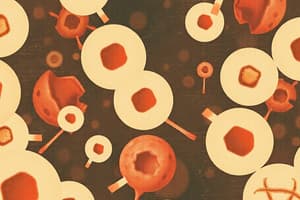Podcast
Questions and Answers
The normal white blood cell count range is from 8000 to 12000 µl.
The normal white blood cell count range is from 8000 to 12000 µl.
False (B)
Leukocytosis can result from conditions such as infections and inflammatory diseases.
Leukocytosis can result from conditions such as infections and inflammatory diseases.
True (A)
White blood cells are less numerous than red blood cells in the body.
White blood cells are less numerous than red blood cells in the body.
True (A)
Leukopenia refers to an increased number of white blood cells.
Leukopenia refers to an increased number of white blood cells.
Pregnancy in the final month is associated with decreased WBC levels.
Pregnancy in the final month is associated with decreased WBC levels.
Manual counting of white blood cells is the only method used for determining WBC counts.
Manual counting of white blood cells is the only method used for determining WBC counts.
Leukemia is a non-malignant condition affecting the bone marrow.
Leukemia is a non-malignant condition affecting the bone marrow.
A mild increase in white blood cells can occur after food intake and returns to normal within an hour.
A mild increase in white blood cells can occur after food intake and returns to normal within an hour.
Neutrophils account for 40-50% of the total white blood cell count.
Neutrophils account for 40-50% of the total white blood cell count.
Basophils are the most numerous type of white blood cell.
Basophils are the most numerous type of white blood cell.
Eosinophils have a role in protecting against infections caused by parasitic worms.
Eosinophils have a role in protecting against infections caused by parasitic worms.
Monocytes are the smallest type of white blood cells.
Monocytes are the smallest type of white blood cells.
On the day of birth, a newborn has a white blood cell count that typically ranges from 9,000 to 30,000 leukocytes.
On the day of birth, a newborn has a white blood cell count that typically ranges from 9,000 to 30,000 leukocytes.
Lymphocytes are predominant in the blood until about 8 years of age.
Lymphocytes are predominant in the blood until about 8 years of age.
All types of white blood cells possess granules in their cytoplasm.
All types of white blood cells possess granules in their cytoplasm.
Lymphocytosis refers to an increased number of neutrophils in the blood.
Lymphocytosis refers to an increased number of neutrophils in the blood.
Flashcards
WBC Count
WBC Count
Measurement of white blood cells per unit volume of blood.
Normal WBC range
Normal WBC range
Typically 5000-11000 cells/µL, varies by age.
Leukocytosis
Leukocytosis
Elevated white blood cell count, often due to infection or inflammation.
Leukemia
Leukemia
Signup and view all the flashcards
Leukopenia
Leukopenia
Signup and view all the flashcards
WBC Count Methods
WBC Count Methods
Signup and view all the flashcards
Physiological Leukocytosis
Physiological Leukocytosis
Signup and view all the flashcards
Infection (WBC)
Infection (WBC)
Signup and view all the flashcards
Granulocytes
Granulocytes
Signup and view all the flashcards
Neutrophils
Neutrophils
Signup and view all the flashcards
Eosinophils
Eosinophils
Signup and view all the flashcards
Basophils
Basophils
Signup and view all the flashcards
Agranulocytes
Agranulocytes
Signup and view all the flashcards
Lymphocytes
Lymphocytes
Signup and view all the flashcards
Monocytes
Monocytes
Signup and view all the flashcards
WBC count Newborn
WBC count Newborn
Signup and view all the flashcards




